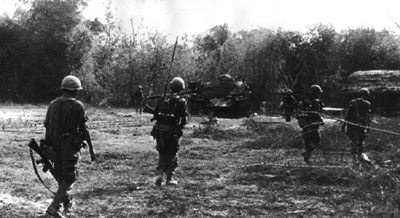- Phase I
|
- Phase
II
|
- Phase III
|
- Mid 65-Mid 66
|
- Mid
66-Late 67
|
- 68-Continuing
|
- • Build up to
400,000
|
-
|
-
|
- • Successful
defense of RVN
|
- • Drove enemy
into sanctuaries
|
- • Destruction
of enemy forces
|
- •
Revitalization and expansion of ARVN
|
- • Improved
and expanded ARVN
|
- • Continued
upgrading of ARVN and territorial forces
|
- • Development
of adequate logistical base
|
- • Encouraged
combined ARVN-US operations
|
- • Preparation
of ARVN to accept ever increasing share of combat
|
-
|
- • Entered
base areas, destroyed supplies, raised enemy losses beyond his input
capabilities
|
- • Continue to
isolate guerrilla from people and help GVN
destroy shadow gov't
|
-
|
- •
Saw free
election, installation of civilian a
|
- • Help GVN to
enhance law and order and to respond government to popular
aspirations
|



